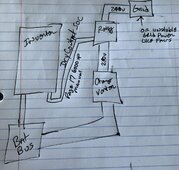MattMan119
Solar Geek
So protection against bad power with generators is common, but when you do fairs and have other unreliable power sources the last thing you want it allowing that power into your inverter to charge … so what if you have the contacts on inverter tripped a relay like
Twidec/Output Single Phase SSR Solid State Relay 100A 3-32V DC to 24-480V AC SSR-100DA https://a.co/d/0hC7Mn3K
That connected power to the chargeverter to charge batteries safely without fear of dirty power ?
Using the inverters contacts allow use of SOC that you can not have on the chargeverter while connected to inverter…
Thoughts?
Better relay choices? This one is limited to 40a and I’m not sure I would trust that ..
Matt
Twidec/Output Single Phase SSR Solid State Relay 100A 3-32V DC to 24-480V AC SSR-100DA https://a.co/d/0hC7Mn3K
That connected power to the chargeverter to charge batteries safely without fear of dirty power ?
Using the inverters contacts allow use of SOC that you can not have on the chargeverter while connected to inverter…
Thoughts?
Better relay choices? This one is limited to 40a and I’m not sure I would trust that ..
Matt



